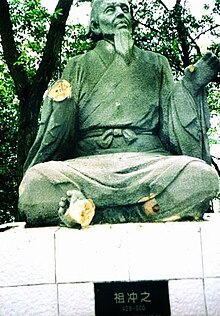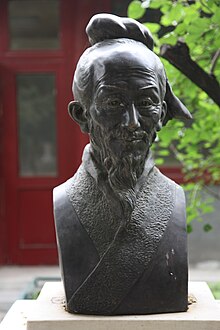To Chongzhi
Zu Chongzhi ( Chinese 祖 沖 之 / 祖 冲 之 , Pinyin Zǔ Chōngzhī , W.-G. TsuCh'ung-chih ; * 429 ; † 500 ) was a Chinese mathematician and astronomer at the time of the Liu Song and Southern Qi dynasties.
Life and work
The ancestors of Zu Chongzhi come from the area of today's Baoding ( Hebei ). Many Chinese from the area of the Eastern Jin Dynasty came to the Yangtze while fleeing the war . With them came his grandfather Zu Chang (祖 Mit). This became the "Minister for Big Works" (大匠 卿) with the Liu Song , he was responsible for the construction projects of the government. Zus's father, Zu Shuo (祖 朔), worked in court and was considered a respectable man.
He himself was born in Jiankang, today's Nanjing . Since his family had a traditional tendency to astronomy and mathematics long before he did, his talent caught on early on and made him known. When Liu Song King Xiaowu found out about his talent, he sent him to the Academy of Hualin Xuesheng (華林 學 省) and later to the Imperial University in Nanjing (Zongmingguan). In 461 he was with the governor in Nanxu (now Zhenjiang , Jiangsu ).
Together with his son Zu Gengzhi , Zu Chongzhi published a mathematics book called "Methods of Interpolation", which is one of the "Ten Mathematical Classics" ( Suanjing shi shu ). Although the book was lost during the Song Dynasty , there are still conjectures about its content: For example, it should contain a number of astronomical calculations (because of the very precise calendar he designed) and a formula for cubic equations, the volume of spheres and the number π be included.
astronomy
Zu was a gifted astronomer who could determine orbital times with great accuracy. His methods of interpolation and integration were way ahead of their time. It is said that even the astronomers of the Song Dynasty and the Indian influenced astronomers of the Tang Dynasty found his methods confusing.
- The sidereal and tropical year
- He recognized the tumbling of the earth and calculated 45 years and 11 months per degree, i.e. H. one cycle in 16,530 years (correct: approx. 25,750 years = 71.5 years per degree).
- Year length
- He calculated the year length as 365.24281481 days (correct: 365.24219878 days, i.e. 99.9998% accurate).
- Orbit of the moon
- The orbital ratio of the earth and moon was determined to be 27.21223 days (correct: 27.21222). This enabled him to predict the four eclipses in the years 436 to 459. The astrology -begeisterten Chinese an important date.
- Orbit of Jupiter
- He calculated the orbital period of Jupiter to be 11.858 years (correct: 11.862 years).
- The Daming Calendar (大 明 曆)
- Even as a student under He Chengtian , he recognized errors in the current calendar system. Together with his teacher, the Yuanjia calendar was developed to correct some errors in the old one. Zu continued to work on the problem and introduced the 463 Daming Calendar. The bureaucracy and the death of the emperor prevented its introduction until 510.
Attention: With the astronomical values it should be noted that mean values are used.
mathematics
The mathematical work of Zu is described in his mathematics book Zhui Shu . Most researchers argue about their complexity. Traditionally, the Chinese have done math with algebra and equations . It is therefore clear that the method is described in his book. Zu used a polygon with 12,288 sides and calculated π with it to eight places. It took 1000 years before someone could do the same. He used the Cavalieri method (about 1000 years before Bonaventura Cavalieri ), also part of the integral calculus , in order to determine the volume of a sphere. He set the ball volume with a radius.
Determination of the circle number
He was able to calculate two values of the circle number π. That was the best approximation for over 900 years. His best approximation was (密 率, Milu , “exact approximation”) or 355/113, the second was (約 率, Yuelu , “rough approximation”) or 22/7. He came to his result by surrounding the circle with a 12.288 (= 2 12 × 3) -sided polygon.
The Japanese mathematician Yoshio Mikami explains:
“22/7 was found centuries before by Archimedes. 355/113 is not found in any Indian, Arabic or Greek manuscript. The value was only found in 1585 by the Dutch mathematician Adriaan Anthoniszoon . That is almost 1000 years after Zu Chongzhi. "
Yoshio Mikami therefore pleads for the break
to be mentioned as a Zu-Chongzhi break . In Chinese literature, it is known as the Zu-Chongzhi ratio . It's the best rational description until you get to
comes.
The south-facing car
The south-facing car was invented by the Chinese mechanic Ma Jun (approx. 200–265). It is a car with an early version of the differential gear . This means that a figure on the wagon always faces south. It is purely mechanical and not a compass that needs a magnetic field . The same technology is used in cars to transmit the same force to the wheels of an axle. At the end of the Three Kingdoms Age , the chariot was forgotten. Nevertheless, Zu Chongzhi succeeded in recreating the car in 478. The book Song Shu (approx. 500) and Nach Chi Shu says:
“When Emperor Wi from Liu Song conquered the Guanzhong Empire, he captured Yao Xing's south-facing chariot. But it was just a shell without the mechanics. A man had to turn the figure inside. During the reign of Sheng-Ming, "Gao Di" commissioned Zi Zu Chongzhi to reconstruct the car. He created a new machine out of bronze that could turn correctly and keep the same direction. There hasn't been anything like it since Ma Jun. "
literature
- Joseph Needham : Science and Civilization in China . Volume 4, Part 2, Caves Books, Ltd., Taipei 1986
- Shiran Du and Shaogeng He: To Chongzhi . In: Encyclopedia of China (Mathematics Edition), 1st ed.
- Joseph Needham: Science and Civilization in China . Volume 3, Mathematics and the Sciences of the Heavens and the Earth . Caves Books, Ltd., Taipei 1986
Web links
- To Chongzhi University of Maine (eng.)
- To Chongzhi biography
- The calendar reform of 462 (eng.) (PDF file; 1.24 MB)
- John J. O'Connor, Edmund F. Robertson : On Chongzhi. In: MacTutor History of Mathematics archive .
| personal data | |
|---|---|
| SURNAME | To, Chongzhi |
| ALTERNATIVE NAMES | 祖 冲 之 (simplified Chinese); 祖 沖 之 (traditional Chinese); Zǔ Chōngzhī (Pinyin); TsuCh'ung-chih (Wade-Giles) |
| BRIEF DESCRIPTION | Chinese mathematician and astronomer |
| DATE OF BIRTH | 429 |
| DATE OF DEATH | 500 |





